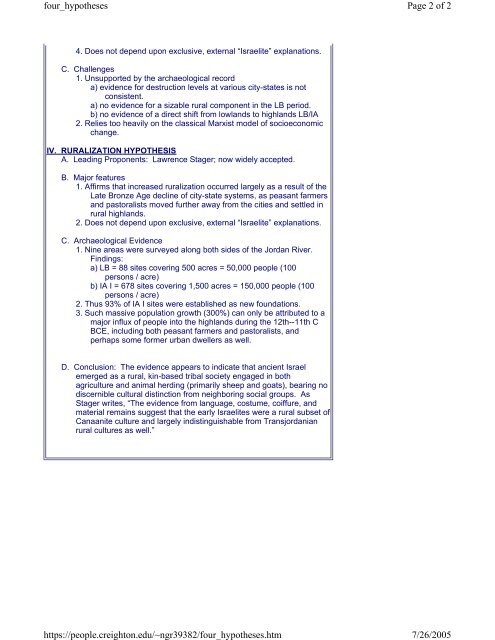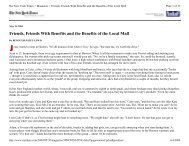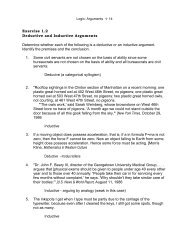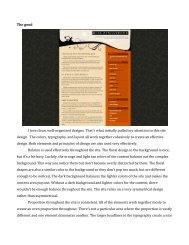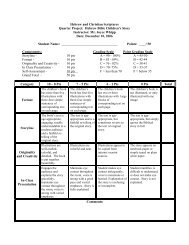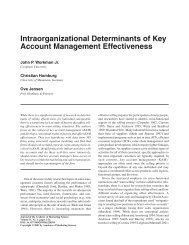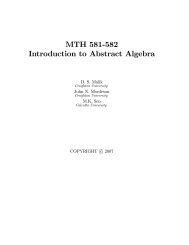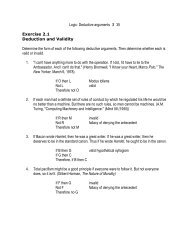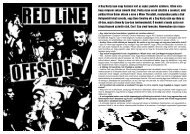Four Hypotheses for the Emergence of Israelite Society
Four Hypotheses for the Emergence of Israelite Society
Four Hypotheses for the Emergence of Israelite Society
You also want an ePaper? Increase the reach of your titles
YUMPU automatically turns print PDFs into web optimized ePapers that Google loves.
four_hypo<strong>the</strong>ses<br />
https://people.creighton.edu/~ngr39382/four_hypo<strong>the</strong>ses.htm<br />
Page 2 <strong>of</strong> 2<br />
7/26/2005<br />
4. Does not depend upon exclusive, external “<strong>Israelite</strong>” explanations.<br />
C. Challenges<br />
1. Unsupported by <strong>the</strong> archaeological record<br />
a) evidence <strong>for</strong> destruction levels at various city-states is not<br />
consistent.<br />
a) no evidence <strong>for</strong> a sizable rural component in <strong>the</strong> LB period.<br />
b) no evidence <strong>of</strong> a direct shift from lowlands to highlands LB/IA<br />
2. Relies too heavily on <strong>the</strong> classical Marxist model <strong>of</strong> socioeconomic<br />
change.<br />
IV. RURALIZATION HYPOTHESIS<br />
A. Leading Proponents: Lawrence Stager; now widely accepted.<br />
B. Major features<br />
1. Affirms that increased ruralization occurred largely as a result <strong>of</strong> <strong>the</strong><br />
Late Bronze Age decline <strong>of</strong> city-state systems, as peasant farmers<br />
and pastoralists moved fur<strong>the</strong>r away from <strong>the</strong> cities and settled in<br />
rural highlands.<br />
2. Does not depend upon exclusive, external “<strong>Israelite</strong>” explanations.<br />
C. Archaeological Evidence<br />
1. Nine areas were surveyed along both sides <strong>of</strong> <strong>the</strong> Jordan River.<br />
Findings:<br />
a) LB = 88 sites covering 500 acres = 50,000 people (100<br />
persons / acre)<br />
b) IA I = 678 sites covering 1,500 acres = 150,000 people (100<br />
persons / acre)<br />
2. Thus 93% <strong>of</strong> IA I sites were established as new foundations.<br />
3. Such massive population growth (300%) can only be attributed to a<br />
major influx <strong>of</strong> people into <strong>the</strong> highlands during <strong>the</strong> 12th--11th C<br />
BCE, including both peasant farmers and pastoralists, and<br />
perhaps some <strong>for</strong>mer urban dwellers as well.<br />
D. Conclusion: The evidence appears to indicate that ancient Israel<br />
emerged as a rural, kin-based tribal society engaged in both<br />
agriculture and animal herding (primarily sheep and goats), bearing no<br />
discernible cultural distinction from neighboring social groups. As<br />
Stager writes, “The evidence from language, costume, coiffure, and<br />
material remains suggest that <strong>the</strong> early <strong>Israelite</strong>s were a rural subset <strong>of</strong><br />
Canaanite culture and largely indistinguishable from Transjordanian<br />
rural cultures as well.”


